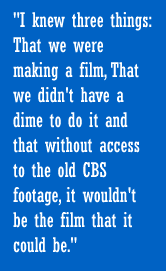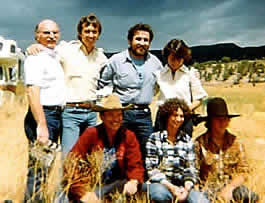|
In 1979, a young producer for CBS
News, on a flight home to NYC, came
across an article in a newspaper.
At the time, 29 year-old Patti Obrow
White had no idea how the story
that she was reading would dramatically
impact her life. The story was about
a controversial alternative program
for troubled youth called, VisionQuest.
 What
captured White's interest was the
unique approach to an often ignored
of problem in the 70's, troubled
kids. The idea of taking angry teens
and putting them on a confrontational
therapeutic wagon train journey
across the western U.S. as an alternative
to lockup was unconventional, innovative
and… under investigation. Would
this tough challenge be enough to
save these "throwaway kids?"
She decided to find out. What
captured White's interest was the
unique approach to an often ignored
of problem in the 70's, troubled
kids. The idea of taking angry teens
and putting them on a confrontational
therapeutic wagon train journey
across the western U.S. as an alternative
to lockup was unconventional, innovative
and… under investigation. Would
this tough challenge be enough to
save these "throwaway kids?"
She decided to find out.
So White decided that it would
be an interesting segment for "30
Minutes" (the teen version
of "60 Minutes"). She
took her crew and headed out to
the Arizona desert to capture the
departure of a wagon train that
would travel 1,500 miles to Denver,
Colorado. It was here, that she
first encountered Bob Burton, the
founder of VisionQuest.
Burton was an imposing figure in a big reservation style cowboy
hat with a presence that was larger-than-life. Burton wasn't thrilled
to see White and her crew. "I really thought I was going to
do the story of them being shut down," she recalled. "There
were allegations of child abuse and their treatment methods were
under investigation by the state, so as a journalist, I thought
I had a great story."
What ensued, was the making of the 1979 "CBS Reports"
documentary, "The Wagon Train Trail."
"Out of ninety kids on the wagon train I had to choose four
or five kids as subjects for the piece," explained White. Her
attention was drawn to a tough street-smart kid with a history of
drugs, runaway and prostitution from Denver, named Tracy. "I
knew she'd be a great film character," recounted White. "She
was attractive, articulate and angry." White was right.
 After
the first shoot, the raw, revealing
and emotionally charged scenes captured
by White along with Associate Producer
Mimi Edmunds, cinematographer Greg
Cooke and soundman Jim Camry that
show Burton passionately confronting
and dealing with the pain of these
abused and abandoned children, and
Tracy, in particular, were riveting. After
the first shoot, the raw, revealing
and emotionally charged scenes captured
by White along with Associate Producer
Mimi Edmunds, cinematographer Greg
Cooke and soundman Jim Camry that
show Burton passionately confronting
and dealing with the pain of these
abused and abandoned children, and
Tracy, in particular, were riveting.
White returned to CBS with the footage and asked CBS News vice-president,
Bob Chandler and Executive Producer of Special Projects, Joel Heller
for an hour. According to White, "In those days, everyone thought
their piece deserved to be an hour." The scenes that were screened
showed Burton confronting Tracy about her plans to runaway from
the wagon train and an interview with Burton.
"There was an immediate interest in the story and according
to White, the concept of following the drama over a period of time
was intriguing to them." This was unusual for her show. In
fact, the only place it would fit was as a "CBS Reports".
She got her hour and made 4 subsequent trips to the wagon train
about every six weeks to document the trials, tribulations, pain
and hope in the lives of four subjects and Burton's attempt to salvage
their lives.
"It focused attention on a group of kids who were considered
society's throw-aways. And this was my first introduction into the
world of these kinds of children and the kind of pain that they
can suffer. Eventually, it was the kids that convinced me that this
program was working," says the filmmaker.
Over the years, White kept in touch with both Tracy and Bob Burton
from time to time, hadn't seen Tracy for the past 11 years. When
Burton called in March of 1999 to tell White that he was taking
Tracy's 12 year-old son, James, into the program, she couldn't believe
it.
Burton went on to explain that Tracy, a struggling single mom with
four children, was a college student and was living in Denver. Burton
described why Tracy needed help with her oldest son, James, who
had been institutionalized in Denver between the ages of six and
twelve.
White, who now had her own production company, Filmsters, asked
Bob for Tracy's number and called her. After catching up on Tracy's
life, Patti asked her if she would consider allowing the cameras
back into her world once again.
When Tracy reconnected with White she was thrilled, "We had
gone through so much together, she knew all of my family history.
There was already a trust there from twenty years ago, so I decided
to think about it," said Tracy. After a few days, Tracy agreed
to allow White to bring the cameras back again.
"I'll never forget that day when she hung up the phone,"
says Lee Anderson, Line Producer and Filmsters partner. "I
knew three things. That we were making a film, that we didn't have
a dime to do it and that without access to the old CBS footage it
wouldn't be the film that it could be."
"I talked to Lee and my other two partners, Michael Miller
and David Dizenfeld," White recalls. "They all agreed
that we would be jumping off of a cliff without a parachute, but
we all knew that this must have happened for a reason.
"It was a film that no one else could make because of my long-term
relationships with the film subjects. It was something that we couldn't
duck away from, so with a lot of faith and hope we decided to do
it."
White and entertainment attorney Dizenfeld immediately went to
work trying to secure licensing rights from CBS, while Miller (who
had worked on the original film) and Anderson went to work.
"We began planning shoots, budgets and trying to find temporary
funding in the form of corporate credit cards, deferred salaries...
anything that would help make this a reality," said Anderson.
Director of Photography, Jim Green and sound engineer Larry Wallace
both of Oklahoma City had never met the Filmsters, but were on board
quickly. "When I found out that it was the follow-up to a film
shot by Greg Cooke, someone whose footsteps I followed into this
business, that was enough for me," says Green.
They agreed to work on spec, believing like the others, that this
was an incredible opportunity to be involved in an independent feature
documentary. Filming began four days later in Oklahoma on the day
that James was inducted into the VisionQuest program.
The drama of Tracy and James' stories unfolded in very unexpected
ways, "We kept leaving each shoot in disbelief. We were amazed
by the emotional moments we captured. Each new shoot seemed to surpass
the last one."
Filmed in several locations, the Filmsters traveled to Oklahoma,
Colorado, Pennsylvania, Montana and Maryland spending 14 months
shooting the documentary. Green shot all primary footage on BetaSP,
while Anderson often shot second camera with a SONY DVX1000. "We
ended up with 170 hours of original footage including the 5 hours
of original CBS 16mm ins and outtakes that we got our hands on because
of Patti's long relationship with CBS," says Anderson.
In order to keep going, the company needed funding.
Partner Michael Miller, who lives in Los Angeles was at a wedding
party, telling a colleague about the amazing 20-year time-arc story
of this "Erin Brockovich-like" mother fighting to save
her son. A major Hollywood star overheard the conversation and immediately
wanted to help. "The next thing you know, we received a check.
It enabled us to keep going. This was soon followed by the same
'angel' bringing an investor from Denver on board," said MIller.
White called upon the talents of veteran award-winning producer/editor
David Ewing for the monumental task of editing the film. With over
20 years in the business, Ewing had edited for practically every
major network and cable entity. White and Anderson had worked with
him in the past on the TBS documentary, "Survival of the Yellowstone
Wolves" a CableACE nominated film.
"It wouldn't be the same film without Dave," says White.
"He has a great story sense and technical skill combined with
the art of visual storytelling." Production and editing assistant
Eric Bannat worked on location in the field and in the editing room.
Mimi Edmunds, associate producer on the first film, assisted with
the story structure. Editing took ten months.
"Things eased a bit and the shoots continued, but the story
kept evolving and we had to find a way to continue," says White.
Miraculously, in the eleventh hour, Dizenfeld brought in AT&T
as a corporate sponsor and we were able to finish editing and posting
the film."
Vice President of Roland
"The film really needed a strong musical presence. We called
upon composer Ron Riddle who added so much emotional texture,"
says White. "Ron did more than just creating a spectacular
score, he arranged and produced the title song, "If I Could"
, with New York recording artist, Baby Jane Dexter. The sound design
and mix for the 119 minute film was done by the talented Skip Sorelle.
Veteran online editor and vice-president of Roland House, Ralph
Quattrucci did post-production at Roland House in Arlington, Virginia
where it was edited. It was then color-corrected and upconverted
the final version to high definition video.
In May 2001, "If I Could" was first screened at a benefit
to help violence prevention. It received a standing ovation from
over 700 people. Baltimore Sun columnist Susan Reimer wrote, "I
watched this film not with a lump in my throat, but with clenched
fists. But by its conclusion, I came to believe, as Bob Burton does,
that while we cannot rehabilitate the victims of such horrific dysfunction,
we must try to "habilitate" them. We can give them the
tools to overcome the trauma of sexual abuse or abandonment and
live life without inflicting them on the next generation."
This was followed by the World Premiere of "If I Could"
at the Seattle International Film Festival where it won 3rd Runner
Up for Best Documentary by popular audience vote. "If I Could"
garnered awards at many film festivals
including the Best Documentary award at the WINFemme Film Festival
in Los Angeles and the Chris Award at the Columbus Film and Video
Festival. "If I Could" will receive a CINE Golden Eagle
in March. It is also a selection for the Denver International Film
Festival and at select festivals in the coming year.
"Families destroy themselves, so families have to heal themselves,"
is the premise of "If I Could." From the outset, White
envisioned a hopeful film. "After years of telling stories
about dysfunctional families and troubled children, I was looking
for the deeper understanding of these issues, something that would
take us to another level in understanding how abuse, abandonment
and trauma play out in families generation after generation."
"Even though "If I Could" is still seeking distribution,
we know that making this film was very important, says White. Based
upon the audience reactions, "If I Could" fills a need,
a need for the REAL kind of reality programming that is lacking
today. We are planning a long life for "If I Could" on
the screen and in outreach for years to come.
"We know that this powerful film will make a difference,"
says director Patti Obrow White.
|